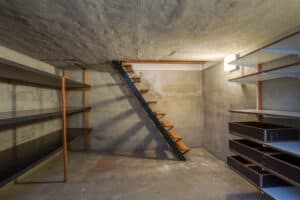
A secured internet connection through Ethernet always provides faster performance than WiFi.
The problem is that you may need the Ethernet in a different room than the router.
We can help you secure your Ethernet to the wall in a safe way that doesn’t detract from your interior decorating.
How To Secure Ethernet Cable To Wall (Step-By-Step)

There are six different methods you can use to secure the Ethernet cable to the wall.
Each method varies in complexity, expense, and the ability to hide the cable from view.
Choose one of the following methods to secure your cable to the wall.
1. Tape
The cheapest and easiest method to secure the Ethernet cable to the wall is with tape.
It won’t last forever, and you’ll need to frequently re-tape the cable.
However, if you’re looking for a budget fix, then this is the method for you.
Follow these steps to secure the Ethernet cable to the wall with tape.
Step 1: Choose The Right Tape
Different types of tape are not created equal.
You need something heavy-duty if you want the cable to stick to the wall for a long time.
Gorilla tape and duct tape are the most effective options on a budget.
If you want to use the cheapest tape, like Scotch tape, then you’re going to need a lot of it.
Scotch tape and packaging tape do not have the same lifespan as duct tape.
It also won’t hold a cable that well.
You’ll need to apply several strips of tape to keep it against the wall.
Buy extras.
Step 2: Measure Out Ethernet Cable
Run the Ethernet cable along the floor in the direction that it needs to go.
Make measurements of where you need to put the tape.
For stronger tape, you’ll need to use fewer strips to keep it against the wall.
Measuring it out beforehand can help you determine whether you have enough tape or not.
Step 3: Press Cable To The Wall And Tape In Place
Hold the cable against the wall where you want to secure it.
Then fold the tape over the cable and secure it to the wall.
If you’re using strong tape, then you should only need to apply the tape every six to 12 inches.
As you move down the line, you’ll be able to see whether the cable is drooping.
If it is, then apply more tape.
If you’re using weaker tape, then you may need to apply strips of tape every other inch or every third inch.
For further security, run a strip of tape horizontally on top of the vertical tape that’s securing the cable.
The horizontal tape will help the vertical tape from peeling.
Step 4: Maintain As Necessary
The tape won’t last long.
For strong tape, you may get a few weeks out of it before it starts to peel away from the wall.
Tape loses adhesion fast.
Weaker types of tape may only last for a few days.
Any time the tape starts to peel, remove it and replace it with a fresh strip of tape.
2. Notecards And Staples

A more effective solution that’s still budget-friendly is to use notecards and a stapler.
This method works best if you need to attach to the baseboards of the wall or run the cable along the doorframe.
Follow these steps to secure the Ethernet cable to the wall using notecards, staples, and a stapler.
Step 1: Purchase The Materials
You’ll need a pack of notecards or a similar product.
Cardstock works, too.
The color of the notecards should match your wall.
It can help it to blend in a little.
If the color isn’t available, then you can always paint it to match.
The staples need to be large.
They offer more security.
Step 2: Wrap The Notecard Around The Cable
Cut the notecards into wide strips.
They should be anywhere from an inch to two inches in width.
Then wrap them around the cable.
You want to create a sizable flap that sticks out from the cable.
Step 3: Staple Flap To The Baseboard/Wall/Doorframe
Not all staples can pierce the wall.
Test a staple to see it if can penetrate the wall.
If so, then this is an ideal method for you.
Staples leave small enough holes that they aren’t noticeable.
If it doesn’t pierce the wall, then run your cable along the bottom or top of the wall.
Use the baseboards or ceiling molding to secure it.
By stapling the flap to the baseboard, you avoid the risk of the staple causing damage to the wire.
The staple will also hold the notecard in place around the cable.
Step 4: Wrap Notecards Every Foot Down The Cable
Repeat the process of wrapping notecards around the cable, then stapling them to the wall.
For extra security, space the notecards out every foot.
If it seems as though the cable is starting to sag, then move the notecards closer together.
Continue along the length of the cable until you’re done.
If you managed to match the notecard to the color of the wall or baseboard, then the notecards are hardly noticeable.
3. Command Strips

The next easiest method to secure an Ethernet cable to the wall is with Command Strips.
These are heavy-duty strips that can attach to the wall without damaging it.
There are even Command Strips specifically made for holding cables.
This option is ideal for those who live in apartments or worry about damaging their walls.
Follow these steps to secure an Ethernet cable to the wall with Command Strips.
Step 1: Purchase Cable-Holder Command Strips
Any kind of Command Strip that has a hook will suffice.
However, if you want the most security for your cable, then you need the cable holder version.
These Command Strips have a thicker base for better adhesion.
They also have a plastic holder in which the cable goes.
You can find them at local grocery stores as well as on Amazon.
Step 2: Place Strips At Measured Locations
The best way to secure your Ethernet cable is to first measure the distances between the Command Strips.
Not only will this make the set-up look uniform, but it also adds more security.
Try placing the Command Strips at every foot.
If you notice the cable is drooping, then place a Command Strip at that point.
Step 3: Attach Cable
Once your strips are in place, you can push the cable into the holders.
Run down the line until your cable is completely secured by the Command Strips.
Step 4: Maintain As Necessary
While Command Strips are more effective than tape, they will lose adhesion eventually.
Buy a few extra to maintain the line as they start to fall off.
The great thing about using Command Strips is that it won’t damage the wall when it falls.
4. Cable Clips
A similar method to the previous one is cable clips.
Cable clips are sometimes more expensive than Command Strips, however.
That said, official cable clips will last longer than Command Strips.
There are different ways to attach them, and there are different widths for the holder.
Follow these steps to use cable clips to secure the Ethernet cable to the wall.
Step 1: Purchase Cable Clips
Your first step is to find the cable clips that are right for your Ethernet cable.
One of the most important aspects is the width of the holder.
Determine the width of your Ethernet cable.
Then choose the cable clip with the holder that matches the width.
This will ensure the clip can hold the cable snugly inside of it.
Step 2: Find Wall Studs
Some cable clips use adhesive to stick to the wall.
In this case, you don’t need to find the wall studs.
These clips won’t last as long as other types of clips.
Adhesion loses durability over time.
If you bought the clips that use nails or screws, then you need to find the wall studs.
Wall studs are the wooden beams and planks that run vertically on the inside of your wall.
You need a stud finder to locate them.
Stud finders can also help you avoid electric wires and plumbing.
Run the stud finder along the wall.
When the stud finder alerts you to a stud, mark the area on the wall with a pencil.
Step 3: Hammer Or Screw Clips To Studs
Depending on the type of clip you have, you may need to first put the Ethernet cable in place.
Otherwise, take your hammer or screwdriver and attach the clip to the studs you marked.
Screws are a better option.
They remain in place more securely than nails.
Step 4: Place Cable Clips A Foot Apart
If possible, place the cable clips a foot apart.
Depending on the distance between the studs, this may be impossible.
A foot’s length apart ensures that the clips can hold your cable without allowing it to droop.
Step 5: Insert Cable
If the cable rests on the outside of the clips, then attach it now.
It inserts within the holder and stays in place.
If the cable rests between the clip and the wall, then you need to slide it into place before securing the clip to the wall.
Run the cable along with the distance it needs to travel, attaching clips as needed.
Your Ethernet cable is now secure against the wall.
5. Cable Raceway
A cable raceway is another great way to secure an Ethernet cable to the wall.
It also hides the cable from view.
Installing it is like cable clips except it requires greater finesse.
Follow these steps to secure the Ethernet cable to the wall with a cable raceway.
Step 1: Purchase A Cable Raceway
Choosing the right cable raceway for your needs is the first step.
Some raceways use adhesion to stick to the walls.
This is ideal for people who live in apartments or don’t want to poke holes in their walls.
Other types of raceways rely on nails or screws to attach to the wall.
This type will offer more security, but it will leave holes in the wall as a result.
The final aspect to consider is the width of the raceway.
You want the cable to fit inside of it.
Measure the Ethernet cable and find a raceway that matches the width.
Step 2: Measure Out The Raceway Or Find Wall Studs
If the raceway uses adhesion, then you don’t need to worry about finding wall studs.
Instead, you can measure out the raceway according to the length of cable that you need to run.
This will ensure you have enough of a cable raceway to use.
Those who are using the raceways with nails or screws need to find the wall studs.
A stud finder can make the job easier.
Pass the stud finder along the wall and mark the areas where the studs are with a pencil.
Step 3: Put Cable In Place
You’ll need to work in sections to keep the cable against the wall.
Take your first section and hold it against the wall where you want to secure it.
You can also use tape to temporarily hold it in place.
Step 4: Secure The Raceway To The Wall
Adhesion raceways can fit over the cable and stick in place.
You may need to remove a protective layer to access the sticky part of the raceway.
Press it hard against the wall and over the cable.
It will hide the cable from view and attach it to the wall.
Raceways with nails or screws need the use of a hammer or screwdriver.
Using the studs as place markers, hammer or screw the raceway into the stud.
The cable should be underneath the raceway.
Once the raceway is secure, the cable should be hiding underneath it and secure to the wall.
Continue along the length of the cable until you’re done.
Step 5: Terminate In An Ethernet Jack (Optional)
If you want to make the end of the cable look nice, then you can terminate it in an Ethernet jack.
The cover allows more devices to plug into the Ethernet cable.
The jack can also attach to the wall and provides a professional-looking finish to the cable raceway.
6. Run Cable Through Baseboard And Against The Wall

This is the most complex method, and it won’t work for everyone.
It depends on the size of the baseboards that you have in the home.
Some baseboards are large enough to fit a cable inside of them.
Flat Ethernet cables can rest against the wall and floor inside of the baseboard.
Follow these steps to secure an Ethernet cable to the wall through a baseboard.
Step 1: Remove Nails Or Screws Holding Baseboard Together
There are two ways to access the inside of your baseboard.
The first is through the top.
Some baseboards use molding that attaches separately.
You can remove the top and insert the cable there.
If the top part doesn’t come off, then you need to remove the entire baseboard.
Take a hammer or screwdriver and remove the nails or screws on the baseboard.
Carefully pull the baseboard away from the wall.
Step 2: Insert Cable
Place the Ethernet cable in the baseboard and against the wall.
The baseboard will secure the cable to the wall, itself.
Run the length of the cable through the baseboard.
The hardest part will be doorways.
At this point, you can either drill a hole through the doorframe for the cable, or you can just wrap it around the doorframe.
To keep the cable against the wall temporarily, use tape.
Step 3: Attach Baseboard Again
Once the cable is in place, nail or screw the baseboard back against the wall.
If you only needed to remove the top part of the baseboard, then replace the molding.
Repeat the process for every piece of baseboard until you have hidden the entire cable.
Once you’re done, the Ethernet cable is secure against the wall and completely out of sight.
Conclusion

Securing the Ethernet cable against the wall is a great way to avoid tripping.
These six methods are effective at securing the cable to the wall.
Each one presents a different level of security and complexity.
Choose a method that works for your needs, budget, and sense of aesthetics to avoid cable eyesores.









Leave a Reply